On June 28, the Bureau of Land Management released its Final Supplemental Environmental Impact Statement for the Roan Plateau, a backcountry area prized as a fish and wildlife oasis and a cornerstone of the area’s recreation-based economy. While TU said it was still reviewing the document, the BLM plan appears to cancel the majority of oil and gas leases on top of the Roan Plateau, including all of those in the Trapper and Northwater Creek watersheds, areas that encompass the best cutthroat trout habitat on the Roan. The East Fork of Parachute Creek headwaters, recently reclaimed and restored for native cutthroat trout, would also remain undeveloped with leases canceled. The BLM’s proposed decision reflects the 2014 settlement reached between Bill Barrett Corporation—the lease holder—and conservation groups.
“This is another big step forward in years-long efforts to protect one of Colorado’s natural treasures,” said David Nickum, executive director of Colorado Trout Unlimited. “It shows that, working together, we can craft a management solution that provides lasting protections for the Roan’s most valuable fish and wildlife habitat, while allowing careful, responsible development of its energy reserves.”
The Roan is a Colorado last best place: its small streams hold rare populations of genetically pure Colorado River cutthroat trout—a species found in less than 10 percent of its historic range. Public lands on the plateau’s top and at its base provide key summer and winter range and migration corridors for large herds of mule deer and elk.
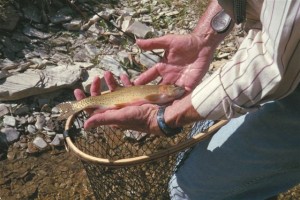
The surrounding landscape is also rich in energy resources and dotted with oil and gas development sites.
“Over the years, our members have invested thousands of dollars and many hundreds of volunteer hours into habitat and fisheries projects on the Roan,” said Ben Bloodworth, president of TU’s Grand Valley Anglers chapter. “It’s a very special place to Colorado sportsmen and women, and this BLM plan will help protect it for future generations to enjoy.”
The BLM release of the FEIS will be followed by a few more steps to secure final protections for the Roan. A 30-day public comment period for the Final Supplemental Environmental Impact Statement and proposed plan begins July 1. After the comment period, the BLM is expected to issue its final Record of Decision.
TU has a long history of involvement with the Roan, beyond being party to the lawsuit and subsequent settlement that set the stage for the BLM's new EIS and plan. TU projects on the Roan have included extensive fencing and riparian plantings along Trapper Creek, Northwater Creek, and parts of the East Fork Parachute Creek watershed; installation of a fish barrier on the East Fork which isolated the upper portion of the stream from downstream brook trout and allowed Colorado Parks and Wildlife to re-establish native cutthroat trout there; and physical habitat improvements on Trapper Creek to provide improved low-water holding habitat. Grand Valley Anglers volunteers have been involved with project work in the area for more than 20 years.
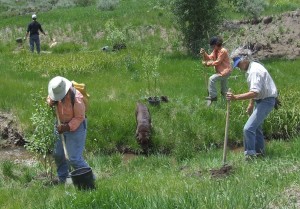






 The water from the Upper Colorado flows from Lake Granby (which acts as the storage facility), then it is is pumped into Shadow Mountain Reservoir where it then flows down into Grand Lake. From Grand Lake, the water then is pumped through the 13.1 mile long Alva B. Adams Tunnel under the Continental Divide and flows into the Big Thompson River. From there, the water drops into power plants that supply the pumps on the western slope.
The water from the Upper Colorado flows from Lake Granby (which acts as the storage facility), then it is is pumped into Shadow Mountain Reservoir where it then flows down into Grand Lake. From Grand Lake, the water then is pumped through the 13.1 mile long Alva B. Adams Tunnel under the Continental Divide and flows into the Big Thompson River. From there, the water drops into power plants that supply the pumps on the western slope.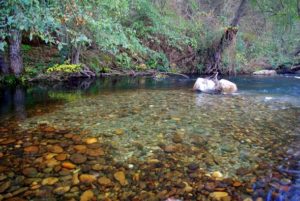 As the flows of the Upper Colorado are depleted by the diversion projects, the natural cleansing of the river fails to occur. Each spring, rivers experience flushing flows- an increase in water flow that breaks up sediment buildup along the stream bed. When the river isn't able to clean itself from sediment buildup between cobblestone, it doesn't allow for insects to hatch or fish to spawn.
As the flows of the Upper Colorado are depleted by the diversion projects, the natural cleansing of the river fails to occur. Each spring, rivers experience flushing flows- an increase in water flow that breaks up sediment buildup along the stream bed. When the river isn't able to clean itself from sediment buildup between cobblestone, it doesn't allow for insects to hatch or fish to spawn. The West needed water to expand. Currently, 80 percent of Colorado's population is on the east of the Divide while 80 percent of the water is on the west side. This means that in order to thrive, water needed to be diverted. The C-BT opened the door to other transmountain diversions- including the Moffat Tunnel from the Fraser River, another tributary of the Upper Colorado headwaters.
The West needed water to expand. Currently, 80 percent of Colorado's population is on the east of the Divide while 80 percent of the water is on the west side. This means that in order to thrive, water needed to be diverted. The C-BT opened the door to other transmountain diversions- including the Moffat Tunnel from the Fraser River, another tributary of the Upper Colorado headwaters.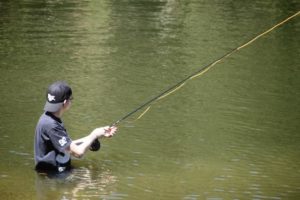 The first day began with a basic entomology class on bugs and their life cycles. Volunteers and camp leaders also showed the students what fish eat, and the flies that represent these species and phases. All of this was don in order to give students a better understanding of what the term “fly” fishing actually means.
The first day began with a basic entomology class on bugs and their life cycles. Volunteers and camp leaders also showed the students what fish eat, and the flies that represent these species and phases. All of this was don in order to give students a better understanding of what the term “fly” fishing actually means.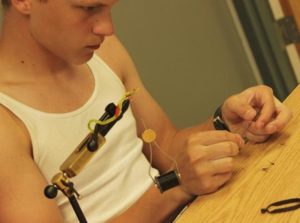
 By: Ameen Hosain
By: Ameen Hosain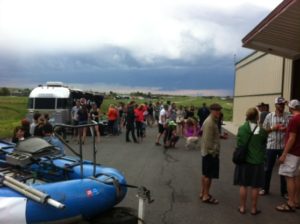
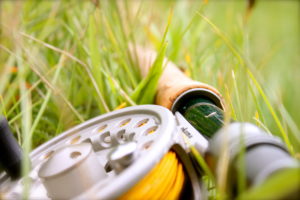

 Thus it is best to keep a fish in the water as much as possible, with a photo being taken swiftly- holding the fish only a few inches above the water.
Thus it is best to keep a fish in the water as much as possible, with a photo being taken swiftly- holding the fish only a few inches above the water.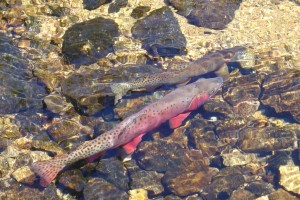 Choosing whether or not to fish to spawning trout is an issue that sees much debate, however with conservation in mind,
Choosing whether or not to fish to spawning trout is an issue that sees much debate, however with conservation in mind, According to
According to 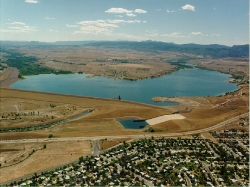 If not one who collects rainwater, another way to assist in the maintenance of healthy water levels is to pay close attention to sprinkler systems; making sure to turn off systems when it rains, and ensuring that they are only used a maximum of three times a week. These things are easy to do and are highly recommended by Denver Water in order to keep Colorado’s reservoirs in good shape.
If not one who collects rainwater, another way to assist in the maintenance of healthy water levels is to pay close attention to sprinkler systems; making sure to turn off systems when it rains, and ensuring that they are only used a maximum of three times a week. These things are easy to do and are highly recommended by Denver Water in order to keep Colorado’s reservoirs in good shape. "Northern pike are aggressive predators with big appetites and if their population continues to grow in Green Mountain Reservoir, that will have profound impact on the fish we have stocked there, as well as potential impacts to the endangered native fish we are currently trying to recover," said CPW's Jon Ewert, aquatic biologist from Hot Sulphur Springs.
"Northern pike are aggressive predators with big appetites and if their population continues to grow in Green Mountain Reservoir, that will have profound impact on the fish we have stocked there, as well as potential impacts to the endangered native fish we are currently trying to recover," said CPW's Jon Ewert, aquatic biologist from Hot Sulphur Springs.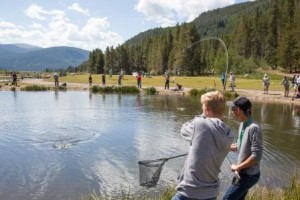
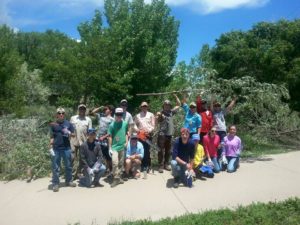
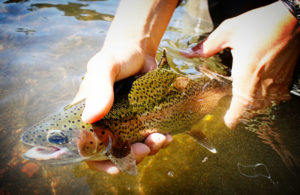
 Thompson Divide is a wildlife haven for big game habitat and is home to designated “outstanding waters” that contain healthy populations of native cutthroat trout. While some of the acreage being proposed for new leases is in areas with relatively low fish and wildlife values compared to the Thompson Divide, other acreage contains important big game hunting habitat and cutthroat trout streams. The draft bill does not address potential protections for this habitat.
Thompson Divide is a wildlife haven for big game habitat and is home to designated “outstanding waters” that contain healthy populations of native cutthroat trout. While some of the acreage being proposed for new leases is in areas with relatively low fish and wildlife values compared to the Thompson Divide, other acreage contains important big game hunting habitat and cutthroat trout streams. The draft bill does not address potential protections for this habitat.
